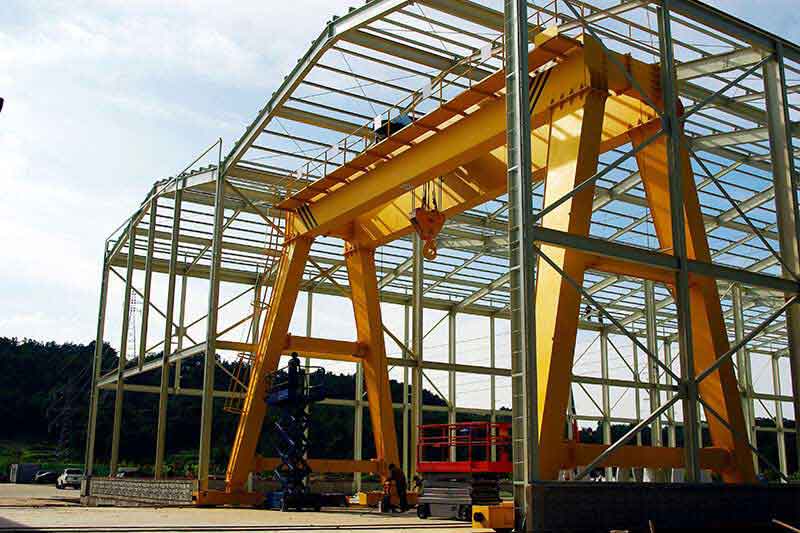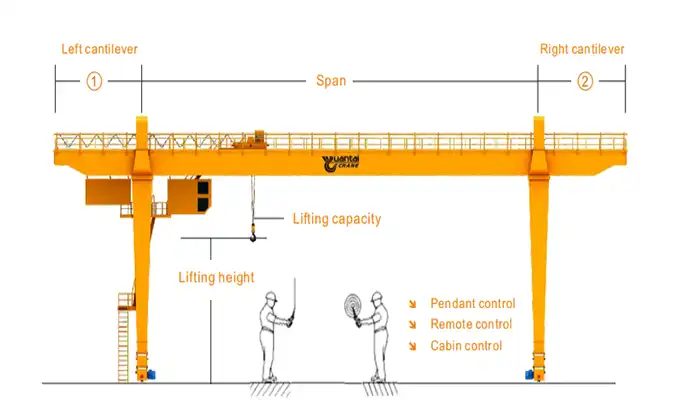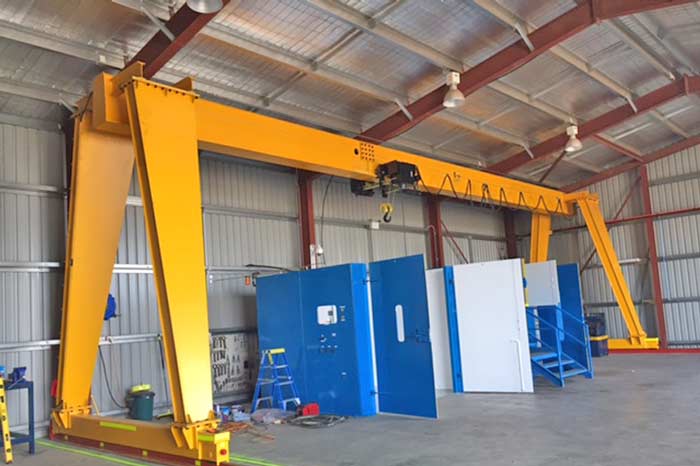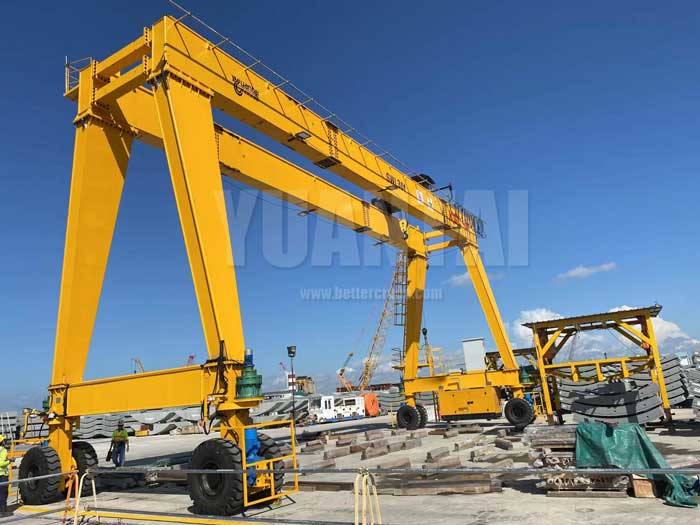Your Essential Guide to Gantry Crane Pricing: What You Need to Know
All You Should Know When Asking for Gantry Crane Price
In the bustling world of industries, where efficiency and productivity reign supreme, the role of gantry cranes is paramount. These stalwart machines are the backbone of material handling operations, facilitating the movement of heavy loads with precision and ease. However, before diving into the realm of gantry crane procurement, it's essential to grasp a fundamental aspect: pricing. Understanding gantry crane pricing is not merely about numbers; it's about making informed decisions that can impact your operations and bottom line. So, before you embark on your journey to acquire a gantry crane, let's delve into the crucial considerations that lay the foundation for successful procurement.
The importance of understanding gantry crane pricing cannot be overstate It's not just about knowing the cost; it's about comprehending the factors that influence it and the value it brings to your operations. Gantry cranes come in various types, sizes, and configurations, each tailored to specific applications and industries. Hence, having a clear understanding of pricing ensures that you invest in the right crane that meets your requirements without breaking the bank. Moreover, being well-versed in gantry crane pricing empowers you to negotiate effectively, maximize your budget, and ultimately achieve the best return on investment.
Before you hit the "send" button on that email requesting gantry crane prices, there are crucial considerations that warrant your attention. Understanding these factors will not only streamline the procurement process but also ensure that you receive accurate quotes tailored to your needs. From determining your lifting capacity requirements to specifying your power source preferences and considering additional features, each aspect plays a pivotal role in shaping the pricing of gantry cranes. By taking stock of these key considerations upfront, you lay a solid foundation for informed decision-making and successful gantry crane procurement.
Understanding Gantry Cranes
Gantry cranes stand as stalwart guardians in the realm of material handling, seamlessly orchestrating the movement of heavy loads with precision and efficiency. Before delving into the intricacies of pricing, it's crucial to develop a solid understanding of these formidable machines.
At their core, gantry cranes are overhead cranes that straddle a workspace or runway. Their distinguishing feature lies in their legs or supports, which are mounted on wheels or rails, allowing them to traverse horizontally along the length of the runway. This unique configuration grants gantry cranes unparalleled versatility, making them indispensable in a variety of industries and applications.

Gantry cranes come in various types, each tailored to specific operational requirements and environments. These include:
- Single Girder Gantry Cranes:Featuring a single beam for lifting and a simplified design, these cranes are ideal for light to moderate lifting applications in workshops, warehouses, and manufacturing facilities.
- Double Girder Gantry Cranes:With two beams for increased lifting capacity and stability, double girder gantry cranes are well-suited for heavy-duty applications in industries such as steel production, shipbuilding, and construction.
- Rubber-Tired Gantry (RTG) Cranes:These cranes are equipped with rubber tires for mobility, allowing them to traverse paved surfaces with ease. RTG cranes are commonly used in container terminals and intermodal yards for stacking and moving shipping containers.
- Rail Mounted Gantry (RMG) Cranes:Mounted on rails for precise horizontal movement, RMG cranes are prevalent in port terminals and rail yards for container handling and stacking operations.
Applications and Industries Where Gantry Cranes Are Used
The versatility of gantry cranes lends itself to a myriad of applications across diverse industries. From manufacturing and construction to logistics and transportation, gantry cranes play a vital role in streamlining material handling operations and enhancing productivity.
In manufacturing facilities, gantry cranes are employed for tasks such as loading and unloading materials, moving heavy machinery, and assembling components. In construction sites, they facilitate the erection of structures, lifting building materials, and transporting equipment.
Gantry cranes also find extensive use in warehouse and distribution centers for stockpile management, order fulfillment, and container handling. In port terminals and shipyards, gantry cranes are indispensable for loading and unloading cargo ships, stacking containers, and facilitating intermodal transfers.
Benefits of Gantry Cranes in Material Handling
The adoption of gantry cranes offers a multitude of benefits that resonate throughout the realm of material handling:
- Efficiency:Gantry cranes streamline material handling processes, reducing manual labor and optimizing workflow efficiency.
- Versatility:With their ability to traverse horizontally and lift heavy loads, gantry cranes can adapt to various operational requirements and environments.
- Safety:Equipped with advanced safety features and controls, gantry cranes ensure safe operation and minimize the risk of accidents and injuries.
- Productivity:By expediting loading, unloading, and transportation activities, gantry cranes enhance productivity and throughput in industrial operations.
In summary, gantry cranes stand as indispensable assets in the realm of material handling, offering unparalleled versatility, efficiency, and safety across a myriad of applications and industries. Understanding their types, applications, and benefits lays a solid foundation for informed decision-making in gantry crane procurement and utilization.
Factors Influencing Gantry Crane Prices
Gantry crane prices are influenced by a myriad of factors, each playing a crucial role in determining the overall cost of acquisition. Understanding these factors is essential for navigating the procurement process effectively and ensuring that you invest in a crane that meets your operational needs without exceeding your budget.

Double girder gantry crane parameters to get specific gantry crane price
Capacity Requirements: 1 ton to 100 tons
The lifting capacity of a gantry crane is perhaps the most significant factor influencing its price. Gantry cranes are available in a wide range of capacities, from small 1-ton cranes suitable for light-duty applications to massive 100-ton cranes designed for heavy industrial operations. As the lifting capacity increases, so do the structural requirements, engineering complexity, and material costs, resulting in higher overall prices.
Span and Height Specifications
The span and height specifications of a gantry crane also play a significant role in determining its price. Longer spans and greater heights require more robust structural components, increased engineering complexity, and additional materials, all of which contribute to higher costs. Moreover, custom span and height requirements may necessitate specialized design and manufacturing processes, further impacting the price of the crane.
Power Source: Electric, Hydraulic, or Manual
The power source of a gantry crane—whether electric or manual—can influence its price in several ways. Electric gantry cranes, powered by electricity, offer precise control and high efficiency but may require additional infrastructure for power supply, potentially increasing upfront costs. Manual gantry cranes, operated by hand or manual winches, are cost-effective but may have limited lifting capacity and operational efficiency compared to powered counterparts.
Additional Features and Customization Options
Gantry cranes can be equipped with a variety of additional features and customization options to enhance their functionality and tailor them to specific operational requirements. These may include features such as variable speed controls, remote operation capabilities, overload protection systems, and specialized lifting attachments. The inclusion of such features and customization options can increase the overall price of the crane but may offer significant benefits in terms of efficiency, safety, and operational flexibility.
Installation and Delivery Costs
The costs associated with the installation and delivery of a gantry crane are important considerations that can impact its overall price. Factors such as site preparation, transportation logistics, and installation complexity can vary significantly depending on the crane's size, weight, and location. Specialized equipment and expertise may be required for installation, particularly in cases involving large or custom-designed cranes, leading to additional costs that should be factored into the procurement budget.
Maintenance and Service Agreements
Finally, maintenance and service agreements are critical considerations that can influence the total cost of ownership of a gantry crane over its lifespan. Investing in a comprehensive maintenance plan and service agreement can help minimize downtime, prolong the crane's operational life, and ensure optimal performance. However, such agreements typically involve additional costs that should be weighed against the potential benefits in terms of reliability and operational efficiency.
In summary, gantry crane prices are influenced by a combination of factors, including lifting capacity, span and height specifications, power source, additional features, installation and delivery costs, and maintenance agreements. By carefully considering these factors and their implications, buyers can make informed decisions that align with their operational requirements and budget constraints.
Pricing Variations for Different Gantry Crane Types
Gantry crane prices can vary significantly depending on the type of crane and its intended application. Understanding these variations is crucial for making informed decisions and ensuring that you invest in the right crane for your specific needs. Let's explore the pricing dynamics for different types of gantry cranes:
Single girder gantry crane with low headroom design
Standard Gantry Cranes
Price Ranges for Different Capacities:
Standard gantry cranes are available in a wide range of lifting capacities, from small-scale 1-ton cranes to heavy-duty 100-ton behemoths.
Price ranges vary based on capacity, with larger-capacity cranes generally commanding higher prices due to increased structural requirements and engineering complexity.
Factors Affecting Pricing:
Factors such as span, height, power source, and additional features can also impact the pricing of standard gantry cranes.
Customization options, such as variable speed controls, remote operation capabilities, and specialized lifting attachments, may incur additional costs.
RTG (Rubber-Tired Gantry) Cranes
Overview of RTG Crane Pricing:
RTG cranes, equipped with rubber tires for mobility, are commonly used in container terminals and intermodal yards.
Pricing for RTG cranes may differ from standard gantry cranes due to specialized design and construction requirements.
Comparison with Standard Gantry Crane Prices:While RTG cranes offer mobility and flexibility, they may come at a higher price point compared to standard gantry cranes.
Factors such as tire maintenance, surface preparation, and operational considerations should be taken into account when comparing prices.
Rail Mounted Gantry Cranes (RMGs)
Price Considerations for Rail-Mounted Configurations:
RMG cranes, mounted on rails for precise horizontal movement, are commonly used in port terminals and rail yards.
Pricing for RMG cranes may vary based on rail infrastructure requirements, installation complexity, and operational considerations.
Advantages and Disadvantages Affecting Cost:
While RMG cranes offer efficient container handling and stacking capabilities, they may require significant upfront investment in rail infrastructure and specialized equipment.
Factors such as rail alignment, maintenance access, and operational efficiency should be evaluated when considering the cost of RMG cranes.
Container Gantry Cranes
Pricing Factors Specific to Container Handling:
Container gantry cranes are specifically designed for the efficient handling of shipping containers in port terminals and container yards.
Pricing considerations may include factors such as container size, stacking height, outreach capacity, and automation features.
Cost Comparison with General-Purpose Gantry Cranes:
While container gantry cranes offer specialized container handling capabilities, they may come at a higher price compared to general-purpose gantry cranes.
Factors such as container throughput, operational efficiency, and long-term ROI should be evaluated when comparing costs.
Understanding the pricing variations for different types of gantry cranes is essential for selecting the right crane for your specific application and budget. By considering factors such as lifting capacity, mobility, specialization, and operational requirements, you can make informed decisions that maximize efficiency and productivity in your material handling operations.
Key Parameters Needed for Gantry Crane Price Requests
When requesting pricing for a gantry crane, it's essential to provide detailed information about your specific requirements to ensure accurate quotes. Here are the key parameters that suppliers typically need to provide you with a comprehensive price estimate:
- Lifting Capacity:Specify the maximum weight that the gantry crane needs to lift and move. This will determine the crane's structural design, components, and overall cost.
- Span and Height Requirements:Provide the dimensions of the area where the gantry crane will operate, including the span (distance between the legs) and the lifting height. These specifications will influence the crane's size, configuration, and pricing.
- Power Source Preference:Indicate your preference for the power source of the gantry crane, whether electric, hydraulic, or manual. Each power source has its advantages and cost implications, so it's essential to choose the option that best suits your needs and budget.
- Additional Features and Customization Needs:Identify any specific features or customization requirements you may need, such as variable speed controls, remote operation capabilities, specialized lifting attachments, or safety features. These additions may affect the crane's price, so be clear about your customization needs.
- E. Installation Location and Environment:Specify whether the gantry crane will be installed indoors or outdoors and provide details about the operating environment, such as temperature extremes, humidity levels, or exposure to corrosive materials. These factors will influence the crane's construction materials, coatings, and overall durability.
- F. Usage Frequency and Operational Requirements:Describe the crane's expected usage frequency and operational requirements, including duty cycle, load handling frequency, and any special handling procedures. This information will help suppliers recommend the most suitable crane configuration and components for your application.
By providing detailed information about these key parameters, you can ensure that suppliers offer you accurate and tailored pricing for your gantry crane needs. Additionally, discussing your requirements with experienced suppliers can help you explore cost-effective solutions and optimize the performance and efficiency of your material handling operations.
Understanding Pricing Terms and Options
When evaluating gantry crane pricing, it's essential to understand the various terms and options used in pricing quotes. Familiarizing yourself with these terms can help you make informed decisions and effectively compare quotes from different suppliers. Here's an overview of the common pricing terms and options you may encounter:
- Ex Works (EXW) Price:The EXW price represents the cost of the gantry crane at the supplier's manufacturing facility. It includes the cost of manufacturing the crane but does not include any transportation, insurance, or export/import duties. The buyer is responsible for arranging and paying for all transportation and associated costs from the supplier's facility to the final destination.
- Free On Board (FOB) Price:The FOB price includes the cost of the gantry crane and its delivery to a specified port or location for export. Once the crane is loaded onto the vessel at the port of origin, the buyer assumes responsibility for all transportation costs, insurance, and import duties incurred during transit to the final destination.
- Cost, Insurance, and Freight (CIF) Price:The CIF price covers the cost of the gantry crane, insurance, and freight charges to deliver the crane to the buyer's designated port of destination. The seller is responsible for arranging and paying for transportation and insurance until the crane reaches the port of destination. However, the buyer assumes responsibility for import duties and any additional costs beyond the port of destination.
- Delivery Duty Paid (DDP) Price:The DDP price includes all costs associated with delivering the gantry crane to the buyer's specified location, including transportation, insurance, import duties, and any other applicable taxes or fees. The seller is responsible for arranging and paying for all aspects of delivery until the crane reaches the buyer's designated delivery address.
- E. Price Breakdown and Budget Considerations:When evaluating gantry crane pricing, it's essential to request a detailed breakdown of costs from suppliers. This breakdown should include the base price of the crane, as well as any additional costs for customization, installation, training, maintenance, and support services. By understanding the components of the price breakdown, you can better assess the overall value proposition and ensure that the crane fits within your budget constraints.
By familiarizing yourself with these pricing terms and options, you can navigate the procurement process more effectively and make informed decisions that align with your budget and operational requirements. Additionally, discussing pricing details with suppliers can help clarify any uncertainties and ensure transparency throughout the purchasing process.
Initiating Requests for Gantry Crane Prices
When you're ready to start the process of acquiring a gantry crane, it's essential to take the right steps to gather accurate pricing information. Here's how to effectively initiate requests for gantry crane prices:
- Gathering Necessary Information:Before reaching out to suppliers, gather all the necessary information about your gantry crane requirements. This includes details such as lifting capacity, span and height requirements, power source preferences, operational needs, and budget constraints. Having this information readily available will ensure that you provide suppliers with clear and specific requirements, leading to more accurate price quotes.
- Researching Reputable Suppliers:Conduct thorough research to identify reputable gantry crane suppliers with a track record of delivering quality products and excellent customer service. Look for suppliers with experience in your industry or application and check online reviews, testimonials, and references from past customers. By choosing reputable suppliers, you can have confidence in the reliability and performance of the gantry crane you purchase.
- Submitting Detailed Requests for Quotes:Once you've identified potential suppliers, submit detailed requests for quotes that clearly outline your gantry crane requirements. Provide comprehensive information about your project specifications, including lifting capacity, span and height requirements, power source preferences, customization needs, installation location, and budget considerations. Be sure to ask for a breakdown of costs to understand what is included in the price quote and identify any additional expenses.
By following these steps and submitting detailed requests for quotes to reputable suppliers, you can gather accurate pricing information for your gantry crane project. This proactive approach will help you make informed decisions and ultimately select the gantry crane solution that best meets your needs and budget.
Evaluating Gantry Crane Proposals
Once you've received proposals for gantry cranes from different suppliers, it's crucial to evaluate them thoroughly to make an informed decision. Here's how to effectively assess and compare gantry crane proposals:
- Comparing Quotes and Specifications:Carefully review the quotes and specifications provided by each supplier to compare the features, capabilities, and pricing of their gantry crane solutions. Pay attention to key factors such as lifting capacity, span and height requirements, power source options, customization features, and delivery timelines. Look for proposals that meet your project requirements while offering competitive pricing and value-added features.
- Verifying Supplier Reputation and Experience:Research the reputation and experience of each supplier to ensure they have a proven track record of delivering high-quality gantry cranes and excellent customer service. Check references, testimonials, and online reviews from past customers to gauge their satisfaction levels and overall experience with the supplier. Choose suppliers with a solid reputation and extensive experience in the gantry crane industry to minimize risks and ensure a smooth purchasing process.
- Considering Long-Term Costs vs. Upfront Investment:Evaluate the total cost of ownership for each gantry crane proposal, taking into account not only the upfront investment but also the long-term maintenance, operating, and lifecycle costs. Consider factors such as maintenance requirements, spare parts availability, energy efficiency, and potential downtime costs when assessing the overall value proposition of each proposal. Opt for gantry crane solutions that offer the best balance between upfront investment and long-term cost-effectiveness.
- Negotiating for the Best Deal:Don't hesitate to negotiate with suppliers to secure the best possible deal on your gantry crane purchase. Discuss pricing, payment terms, delivery schedules, warranty coverage, and any additional services or support offerings to find mutually beneficial terms. Be prepared to leverage competitive quotes and highlight your willingness to commit to a long-term partnership to negotiate favorable terms and maximize value for your investment.
By carefully evaluating gantry crane proposals based on these criteria and negotiating with suppliers to achieve favorable terms, you can confidently select the best gantry crane solution for your project needs. Remember to prioritize quality, reliability, and long-term value when making your final decision, and don't hesitate to seek clarification or additional information from suppliers as needed.
Send Us A Quotation to Get Your Gantry Crane Price

- Crane Type:____________ Singl Girder or Double Girder, RMG or RTG
- Load Capacity:____________
- Span Length:____________
- Cantilever length if required: Left cantilever:____________ Right cantilever:____________
- Lifting Height:____________
- Power Source:____________
- Crane control: Pendant Control, Cabin Control, Remote Control
- Installation Requirements: :____________ ( Indoor use or outdoor use )
- Special requirement: :____________
Conclusion
As you wrap up your journey to obtain gantry crane prices, it's essential to reflect on the key points discussed throughout the process. Here's a summary to guide you in making informed decisions:
Recap of Key Points for Obtaining Gantry Crane Prices:
Take the time to understand the specific requirements of your gantry crane project, including lifting capacity, span and height specifications, power source preferences, and customization needs.
Research reputable suppliers with a proven track record of delivering high-quality gantry cranes and excellent customer service.
Submit detailed requests for quotes that clearly outline your project specifications and budget constraints to ensure accurate pricing information.
Evaluate gantry crane proposals based on factors such as pricing, specifications, supplier reputation, and long-term cost considerations.
Negotiate with suppliers to secure the best possible deal and ensure that all aspects of the agreement are clearly defined and agreed upon.
Making informed decisions when procuring a gantry crane is crucial to ensuring the success of your project and maximizing the value of your investment. By carefully considering all relevant factors and thoroughly evaluating gantry crane proposals, you can make decisions that align with your project requirements, budget, and long-term goals. If you have any need , please feel free to contact us to check what we can do for your needs.
.




